MBA501 - Dynamic Strategy: Facebook Stakeholder Analysis Report
VerifiedAdded on 2022/10/10
|10
|1967
|121
Report
AI Summary
This report provides a comprehensive stakeholder analysis of Facebook, examining its mission, vision, recent developments, and industry trends. It presents a stakeholder view model, identifying and describing specific stakeholder groups, including internal stakeholders such as the CEO, managers, and employees, and external stakeholders like the community, individual users, government, and advertisers. The analysis delves into four key stakeholder groups: users, employees, advertisers, and the CEO, assessing their influence and the company's strategies to manage their interests, including discussions on the Cambridge Analytica scandal and the company's CSR activities. The report explores the impact of these stakeholders on Facebook's operations and its approach to privacy, innovation, and revenue generation, providing a detailed overview of the company's stakeholder management.
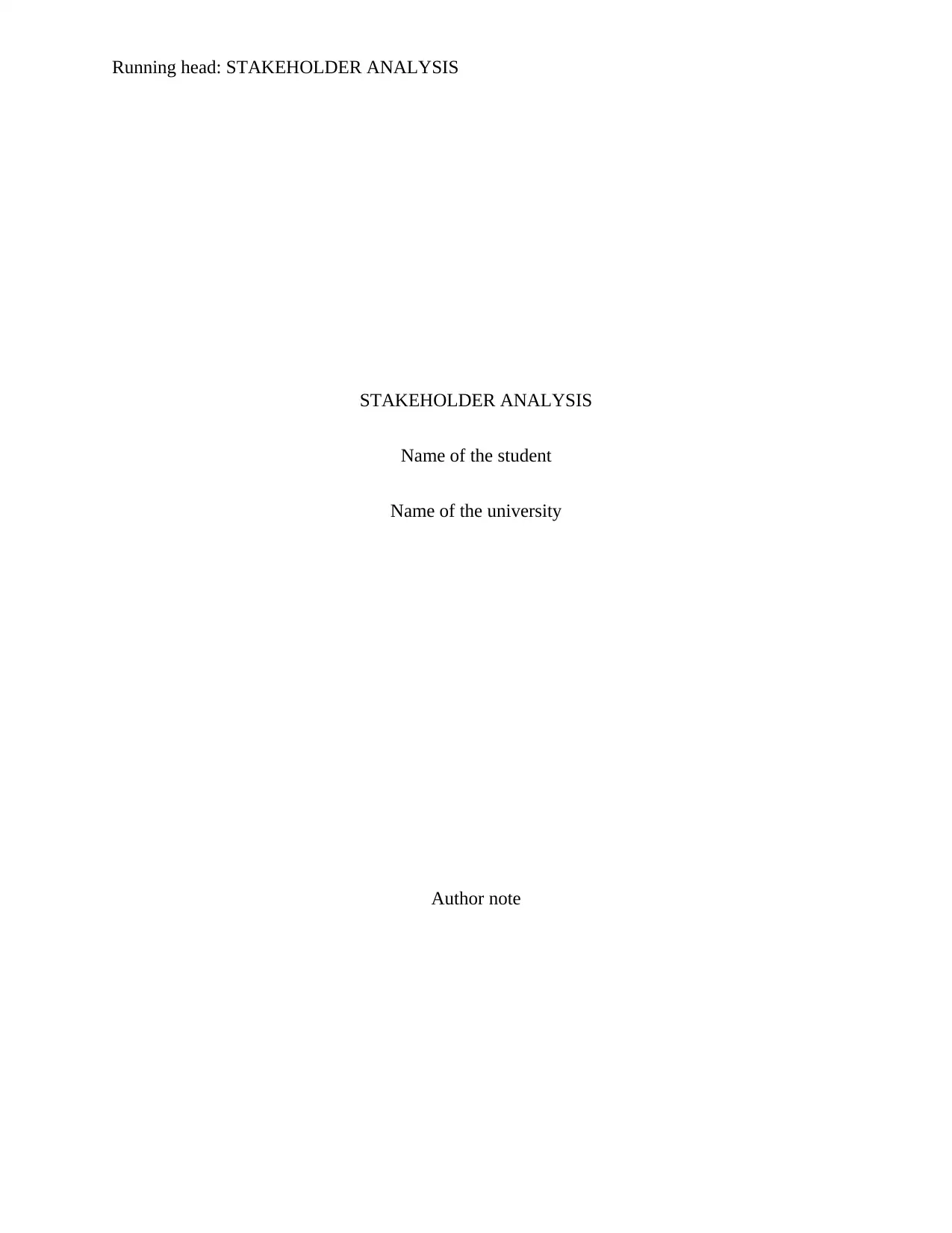
Running head: STAKEHOLDER ANALYSIS
STAKEHOLDER ANALYSIS
Name of the student
Name of the university
Author note
STAKEHOLDER ANALYSIS
Name of the student
Name of the university
Author note
Paraphrase This Document
Need a fresh take? Get an instant paraphrase of this document with our AI Paraphraser
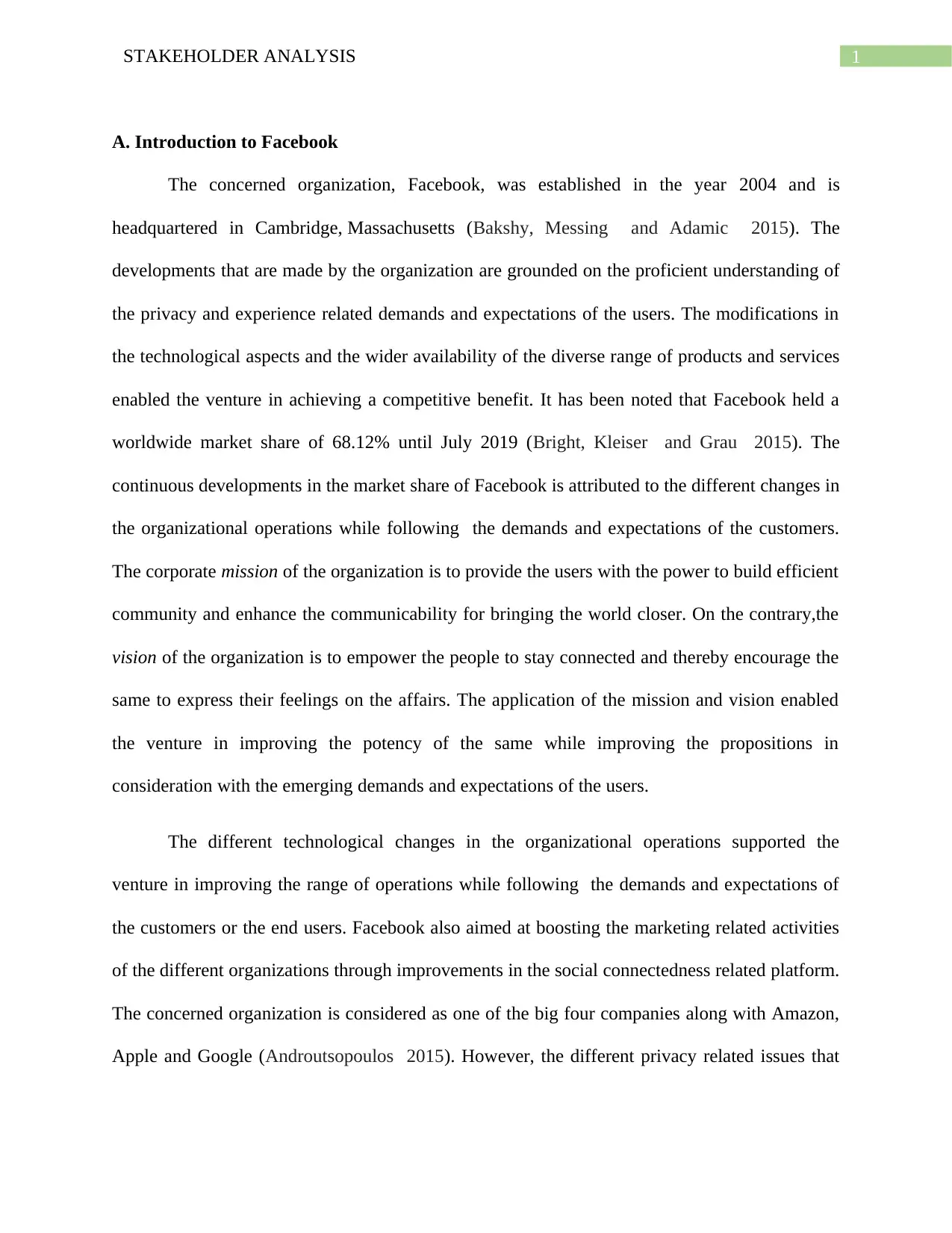
1STAKEHOLDER ANALYSIS
A. Introduction to Facebook
The concerned organization, Facebook, was established in the year 2004 and is
headquartered in Cambridge, Massachusetts (Bakshy, Messing and Adamic 2015). The
developments that are made by the organization are grounded on the proficient understanding of
the privacy and experience related demands and expectations of the users. The modifications in
the technological aspects and the wider availability of the diverse range of products and services
enabled the venture in achieving a competitive benefit. It has been noted that Facebook held a
worldwide market share of 68.12% until July 2019 (Bright, Kleiser and Grau 2015). The
continuous developments in the market share of Facebook is attributed to the different changes in
the organizational operations while following the demands and expectations of the customers.
The corporate mission of the organization is to provide the users with the power to build efficient
community and enhance the communicability for bringing the world closer. On the contrary,the
vision of the organization is to empower the people to stay connected and thereby encourage the
same to express their feelings on the affairs. The application of the mission and vision enabled
the venture in improving the potency of the same while improving the propositions in
consideration with the emerging demands and expectations of the users.
The different technological changes in the organizational operations supported the
venture in improving the range of operations while following the demands and expectations of
the customers or the end users. Facebook also aimed at boosting the marketing related activities
of the different organizations through improvements in the social connectedness related platform.
The concerned organization is considered as one of the big four companies along with Amazon,
Apple and Google (Androutsopoulos 2015). However, the different privacy related issues that
A. Introduction to Facebook
The concerned organization, Facebook, was established in the year 2004 and is
headquartered in Cambridge, Massachusetts (Bakshy, Messing and Adamic 2015). The
developments that are made by the organization are grounded on the proficient understanding of
the privacy and experience related demands and expectations of the users. The modifications in
the technological aspects and the wider availability of the diverse range of products and services
enabled the venture in achieving a competitive benefit. It has been noted that Facebook held a
worldwide market share of 68.12% until July 2019 (Bright, Kleiser and Grau 2015). The
continuous developments in the market share of Facebook is attributed to the different changes in
the organizational operations while following the demands and expectations of the customers.
The corporate mission of the organization is to provide the users with the power to build efficient
community and enhance the communicability for bringing the world closer. On the contrary,the
vision of the organization is to empower the people to stay connected and thereby encourage the
same to express their feelings on the affairs. The application of the mission and vision enabled
the venture in improving the potency of the same while improving the propositions in
consideration with the emerging demands and expectations of the users.
The different technological changes in the organizational operations supported the
venture in improving the range of operations while following the demands and expectations of
the customers or the end users. Facebook also aimed at boosting the marketing related activities
of the different organizations through improvements in the social connectedness related platform.
The concerned organization is considered as one of the big four companies along with Amazon,
Apple and Google (Androutsopoulos 2015). However, the different privacy related issues that
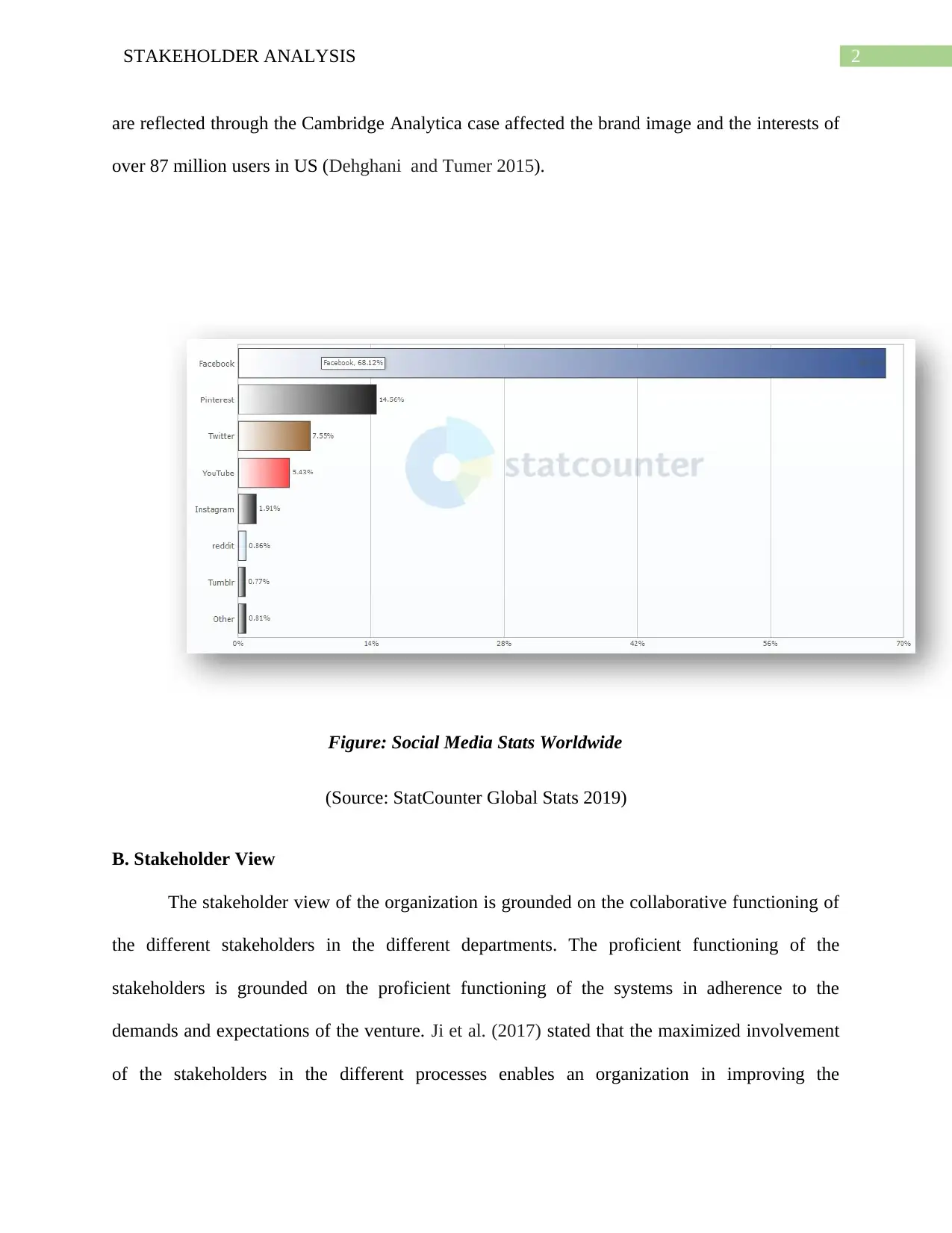
2STAKEHOLDER ANALYSIS
are reflected through the Cambridge Analytica case affected the brand image and the interests of
over 87 million users in US (Dehghani and Tumer 2015).
Figure: Social Media Stats Worldwide
(Source: StatCounter Global Stats 2019)
B. Stakeholder View
The stakeholder view of the organization is grounded on the collaborative functioning of
the different stakeholders in the different departments. The proficient functioning of the
stakeholders is grounded on the proficient functioning of the systems in adherence to the
demands and expectations of the venture. Ji et al. (2017) stated that the maximized involvement
of the stakeholders in the different processes enables an organization in improving the
are reflected through the Cambridge Analytica case affected the brand image and the interests of
over 87 million users in US (Dehghani and Tumer 2015).
Figure: Social Media Stats Worldwide
(Source: StatCounter Global Stats 2019)
B. Stakeholder View
The stakeholder view of the organization is grounded on the collaborative functioning of
the different stakeholders in the different departments. The proficient functioning of the
stakeholders is grounded on the proficient functioning of the systems in adherence to the
demands and expectations of the venture. Ji et al. (2017) stated that the maximized involvement
of the stakeholders in the different processes enables an organization in improving the
⊘ This is a preview!⊘
Do you want full access?
Subscribe today to unlock all pages.

Trusted by 1+ million students worldwide
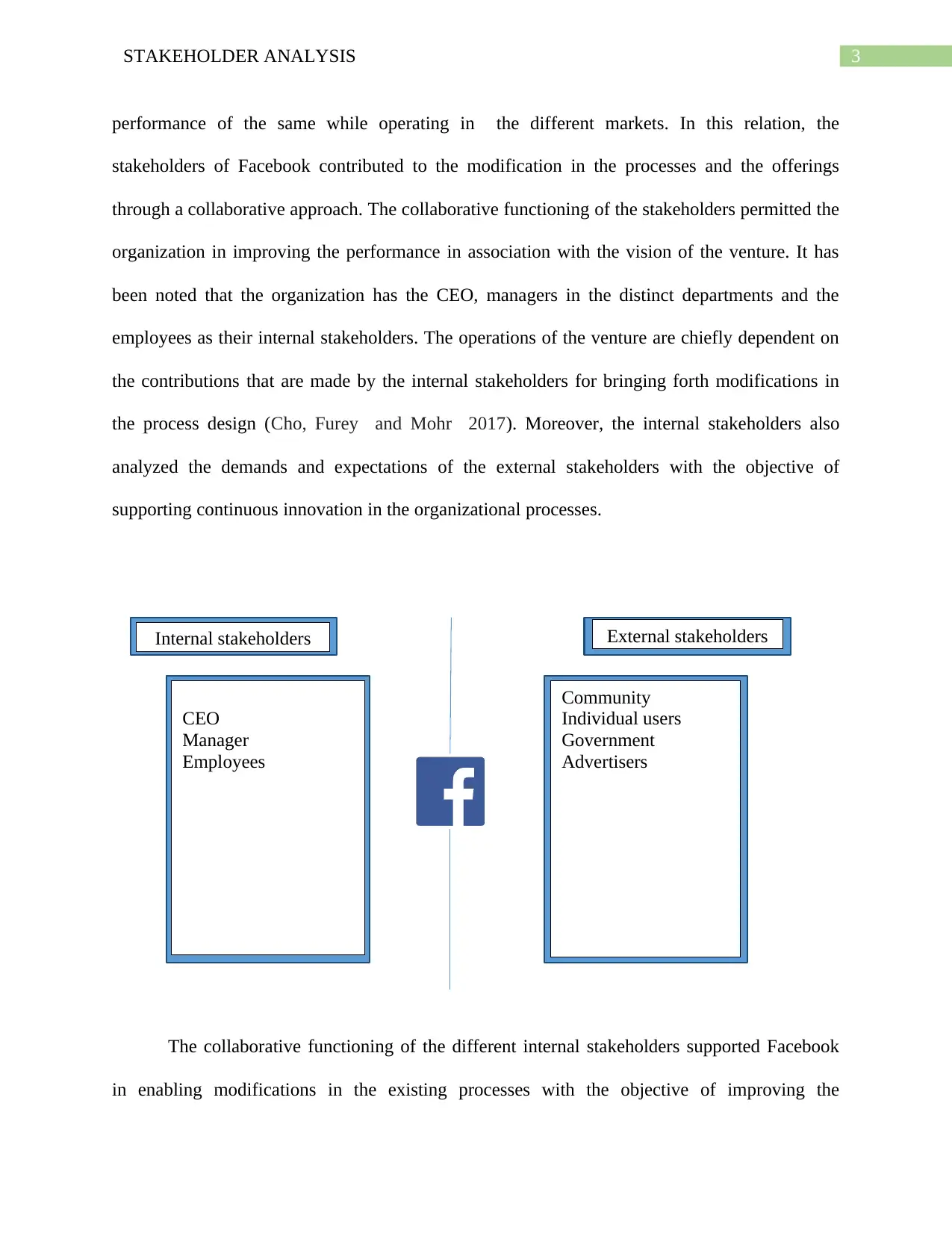
3STAKEHOLDER ANALYSIS
Internal stakeholders External stakeholders
CEO
Manager
Employees
Community
Individual users
Government
Advertisers
performance of the same while operating in the different markets. In this relation, the
stakeholders of Facebook contributed to the modification in the processes and the offerings
through a collaborative approach. The collaborative functioning of the stakeholders permitted the
organization in improving the performance in association with the vision of the venture. It has
been noted that the organization has the CEO, managers in the distinct departments and the
employees as their internal stakeholders. The operations of the venture are chiefly dependent on
the contributions that are made by the internal stakeholders for bringing forth modifications in
the process design (Cho, Furey and Mohr 2017). Moreover, the internal stakeholders also
analyzed the demands and expectations of the external stakeholders with the objective of
supporting continuous innovation in the organizational processes.
The collaborative functioning of the different internal stakeholders supported Facebook
in enabling modifications in the existing processes with the objective of improving the
Internal stakeholders External stakeholders
CEO
Manager
Employees
Community
Individual users
Government
Advertisers
performance of the same while operating in the different markets. In this relation, the
stakeholders of Facebook contributed to the modification in the processes and the offerings
through a collaborative approach. The collaborative functioning of the stakeholders permitted the
organization in improving the performance in association with the vision of the venture. It has
been noted that the organization has the CEO, managers in the distinct departments and the
employees as their internal stakeholders. The operations of the venture are chiefly dependent on
the contributions that are made by the internal stakeholders for bringing forth modifications in
the process design (Cho, Furey and Mohr 2017). Moreover, the internal stakeholders also
analyzed the demands and expectations of the external stakeholders with the objective of
supporting continuous innovation in the organizational processes.
The collaborative functioning of the different internal stakeholders supported Facebook
in enabling modifications in the existing processes with the objective of improving the
Paraphrase This Document
Need a fresh take? Get an instant paraphrase of this document with our AI Paraphraser
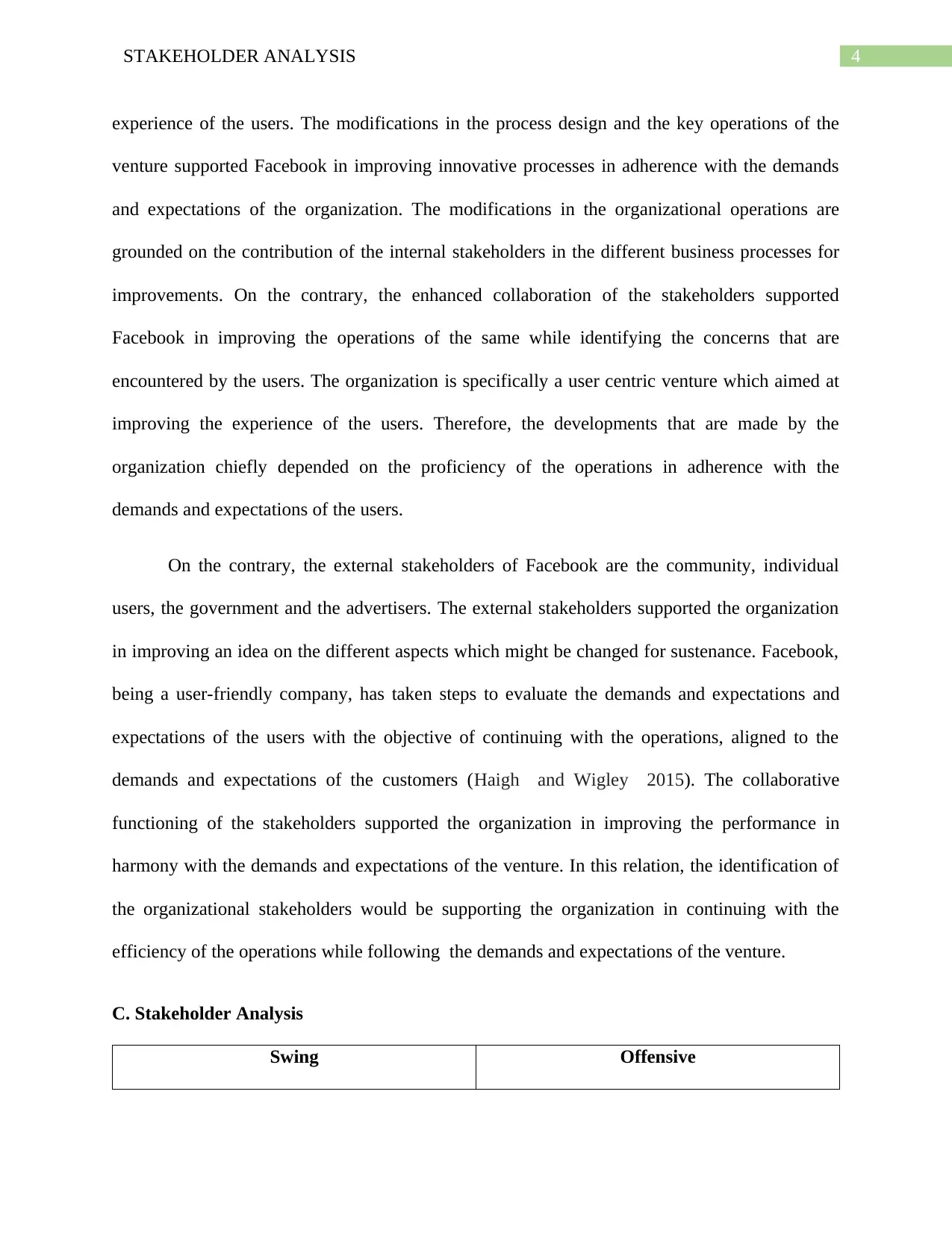
4STAKEHOLDER ANALYSIS
experience of the users. The modifications in the process design and the key operations of the
venture supported Facebook in improving innovative processes in adherence with the demands
and expectations of the organization. The modifications in the organizational operations are
grounded on the contribution of the internal stakeholders in the different business processes for
improvements. On the contrary, the enhanced collaboration of the stakeholders supported
Facebook in improving the operations of the same while identifying the concerns that are
encountered by the users. The organization is specifically a user centric venture which aimed at
improving the experience of the users. Therefore, the developments that are made by the
organization chiefly depended on the proficiency of the operations in adherence with the
demands and expectations of the users.
On the contrary, the external stakeholders of Facebook are the community, individual
users, the government and the advertisers. The external stakeholders supported the organization
in improving an idea on the different aspects which might be changed for sustenance. Facebook,
being a user-friendly company, has taken steps to evaluate the demands and expectations and
expectations of the users with the objective of continuing with the operations, aligned to the
demands and expectations of the customers (Haigh and Wigley 2015). The collaborative
functioning of the stakeholders supported the organization in improving the performance in
harmony with the demands and expectations of the venture. In this relation, the identification of
the organizational stakeholders would be supporting the organization in continuing with the
efficiency of the operations while following the demands and expectations of the venture.
C. Stakeholder Analysis
Swing Offensive
experience of the users. The modifications in the process design and the key operations of the
venture supported Facebook in improving innovative processes in adherence with the demands
and expectations of the organization. The modifications in the organizational operations are
grounded on the contribution of the internal stakeholders in the different business processes for
improvements. On the contrary, the enhanced collaboration of the stakeholders supported
Facebook in improving the operations of the same while identifying the concerns that are
encountered by the users. The organization is specifically a user centric venture which aimed at
improving the experience of the users. Therefore, the developments that are made by the
organization chiefly depended on the proficiency of the operations in adherence with the
demands and expectations of the users.
On the contrary, the external stakeholders of Facebook are the community, individual
users, the government and the advertisers. The external stakeholders supported the organization
in improving an idea on the different aspects which might be changed for sustenance. Facebook,
being a user-friendly company, has taken steps to evaluate the demands and expectations and
expectations of the users with the objective of continuing with the operations, aligned to the
demands and expectations of the customers (Haigh and Wigley 2015). The collaborative
functioning of the stakeholders supported the organization in improving the performance in
harmony with the demands and expectations of the venture. In this relation, the identification of
the organizational stakeholders would be supporting the organization in continuing with the
efficiency of the operations while following the demands and expectations of the venture.
C. Stakeholder Analysis
Swing Offensive
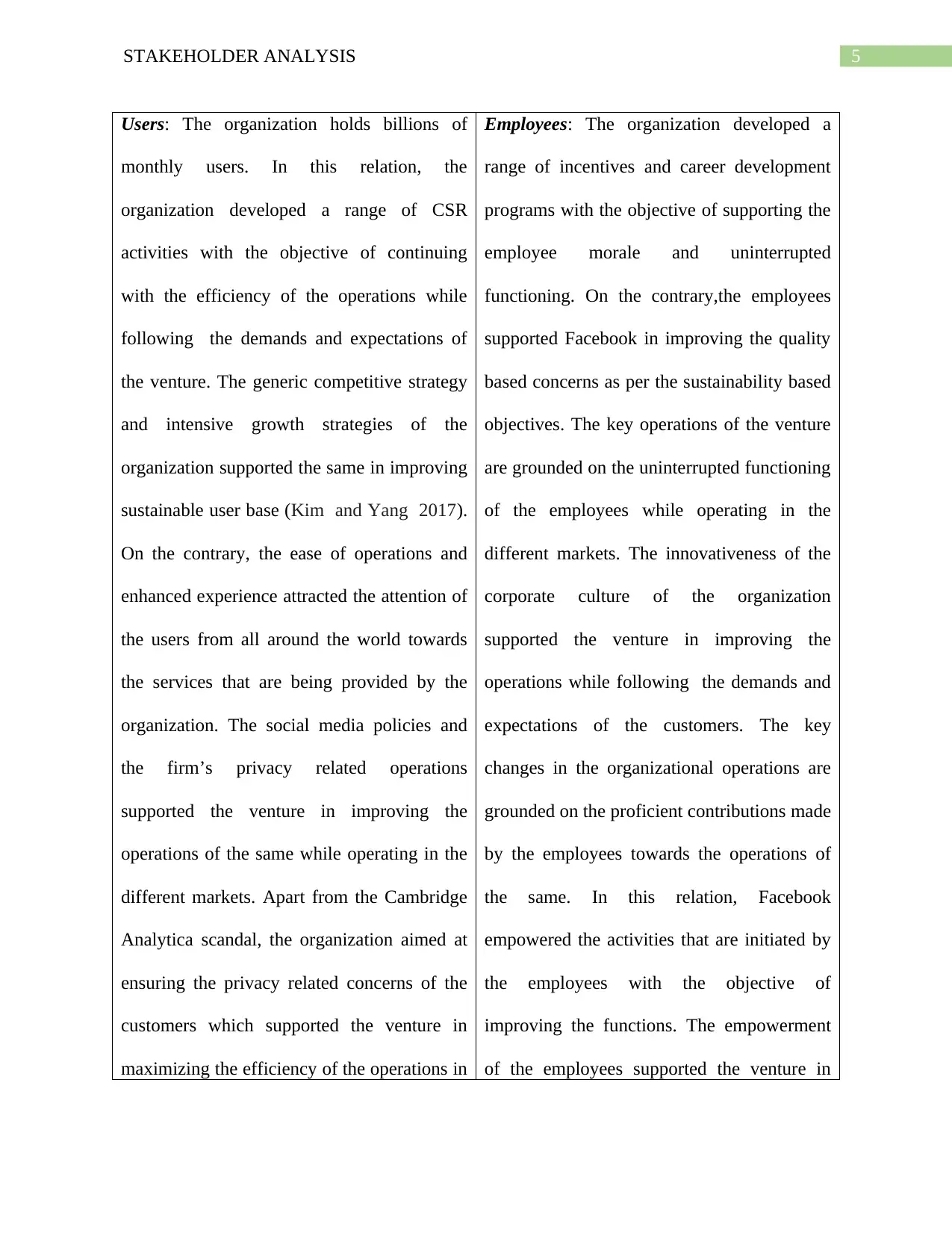
5STAKEHOLDER ANALYSIS
Users: The organization holds billions of
monthly users. In this relation, the
organization developed a range of CSR
activities with the objective of continuing
with the efficiency of the operations while
following the demands and expectations of
the venture. The generic competitive strategy
and intensive growth strategies of the
organization supported the same in improving
sustainable user base (Kim and Yang 2017).
On the contrary, the ease of operations and
enhanced experience attracted the attention of
the users from all around the world towards
the services that are being provided by the
organization. The social media policies and
the firm’s privacy related operations
supported the venture in improving the
operations of the same while operating in the
different markets. Apart from the Cambridge
Analytica scandal, the organization aimed at
ensuring the privacy related concerns of the
customers which supported the venture in
maximizing the efficiency of the operations in
Employees: The organization developed a
range of incentives and career development
programs with the objective of supporting the
employee morale and uninterrupted
functioning. On the contrary,the employees
supported Facebook in improving the quality
based concerns as per the sustainability based
objectives. The key operations of the venture
are grounded on the uninterrupted functioning
of the employees while operating in the
different markets. The innovativeness of the
corporate culture of the organization
supported the venture in improving the
operations while following the demands and
expectations of the customers. The key
changes in the organizational operations are
grounded on the proficient contributions made
by the employees towards the operations of
the same. In this relation, Facebook
empowered the activities that are initiated by
the employees with the objective of
improving the functions. The empowerment
of the employees supported the venture in
Users: The organization holds billions of
monthly users. In this relation, the
organization developed a range of CSR
activities with the objective of continuing
with the efficiency of the operations while
following the demands and expectations of
the venture. The generic competitive strategy
and intensive growth strategies of the
organization supported the same in improving
sustainable user base (Kim and Yang 2017).
On the contrary, the ease of operations and
enhanced experience attracted the attention of
the users from all around the world towards
the services that are being provided by the
organization. The social media policies and
the firm’s privacy related operations
supported the venture in improving the
operations of the same while operating in the
different markets. Apart from the Cambridge
Analytica scandal, the organization aimed at
ensuring the privacy related concerns of the
customers which supported the venture in
maximizing the efficiency of the operations in
Employees: The organization developed a
range of incentives and career development
programs with the objective of supporting the
employee morale and uninterrupted
functioning. On the contrary,the employees
supported Facebook in improving the quality
based concerns as per the sustainability based
objectives. The key operations of the venture
are grounded on the uninterrupted functioning
of the employees while operating in the
different markets. The innovativeness of the
corporate culture of the organization
supported the venture in improving the
operations while following the demands and
expectations of the customers. The key
changes in the organizational operations are
grounded on the proficient contributions made
by the employees towards the operations of
the same. In this relation, Facebook
empowered the activities that are initiated by
the employees with the objective of
improving the functions. The empowerment
of the employees supported the venture in
⊘ This is a preview!⊘
Do you want full access?
Subscribe today to unlock all pages.

Trusted by 1+ million students worldwide
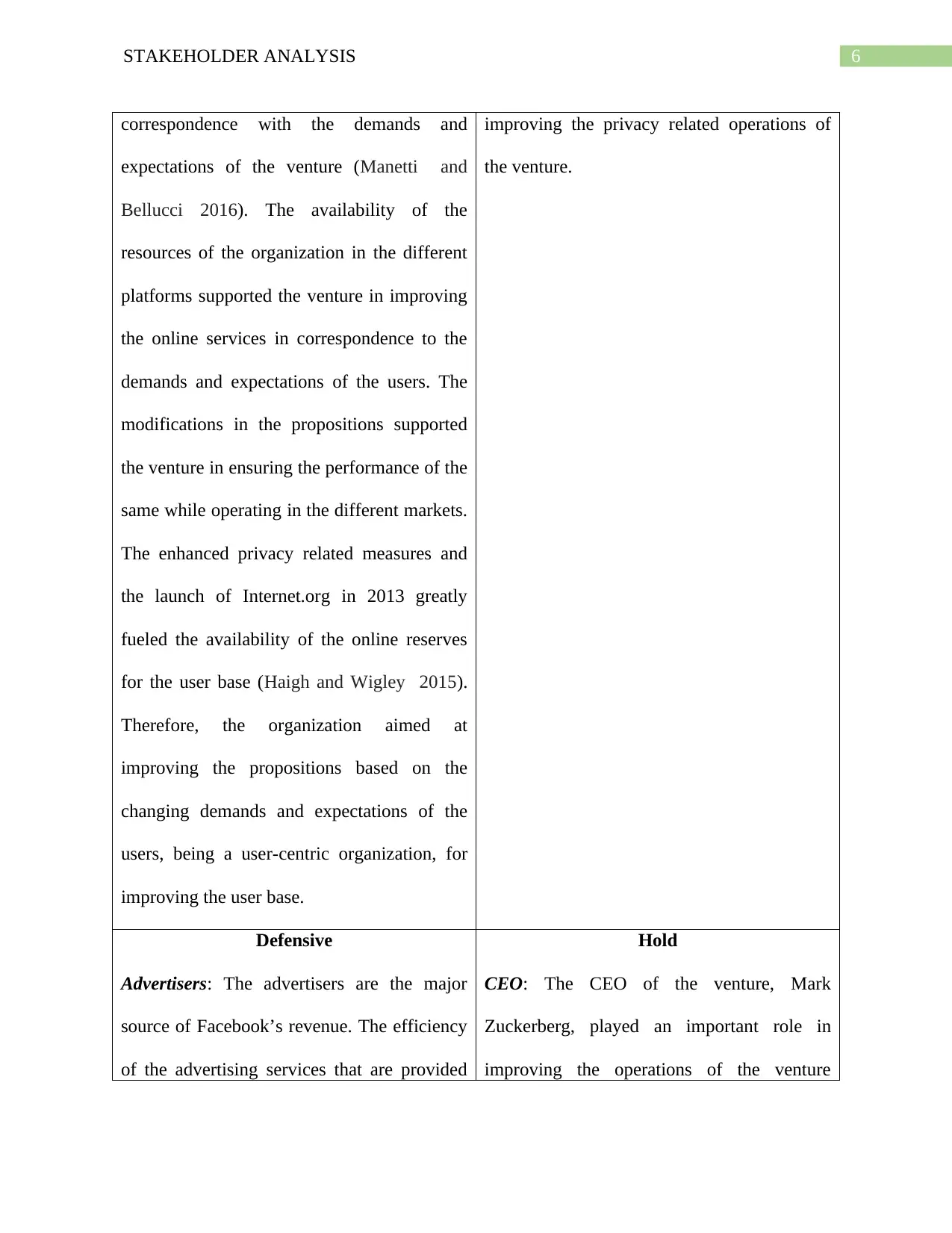
6STAKEHOLDER ANALYSIS
correspondence with the demands and
expectations of the venture (Manetti and
Bellucci 2016). The availability of the
resources of the organization in the different
platforms supported the venture in improving
the online services in correspondence to the
demands and expectations of the users. The
modifications in the propositions supported
the venture in ensuring the performance of the
same while operating in the different markets.
The enhanced privacy related measures and
the launch of Internet.org in 2013 greatly
fueled the availability of the online reserves
for the user base (Haigh and Wigley 2015).
Therefore, the organization aimed at
improving the propositions based on the
changing demands and expectations of the
users, being a user-centric organization, for
improving the user base.
improving the privacy related operations of
the venture.
Defensive
Advertisers: The advertisers are the major
source of Facebook’s revenue. The efficiency
of the advertising services that are provided
Hold
CEO: The CEO of the venture, Mark
Zuckerberg, played an important role in
improving the operations of the venture
correspondence with the demands and
expectations of the venture (Manetti and
Bellucci 2016). The availability of the
resources of the organization in the different
platforms supported the venture in improving
the online services in correspondence to the
demands and expectations of the users. The
modifications in the propositions supported
the venture in ensuring the performance of the
same while operating in the different markets.
The enhanced privacy related measures and
the launch of Internet.org in 2013 greatly
fueled the availability of the online reserves
for the user base (Haigh and Wigley 2015).
Therefore, the organization aimed at
improving the propositions based on the
changing demands and expectations of the
users, being a user-centric organization, for
improving the user base.
improving the privacy related operations of
the venture.
Defensive
Advertisers: The advertisers are the major
source of Facebook’s revenue. The efficiency
of the advertising services that are provided
Hold
CEO: The CEO of the venture, Mark
Zuckerberg, played an important role in
improving the operations of the venture
Paraphrase This Document
Need a fresh take? Get an instant paraphrase of this document with our AI Paraphraser
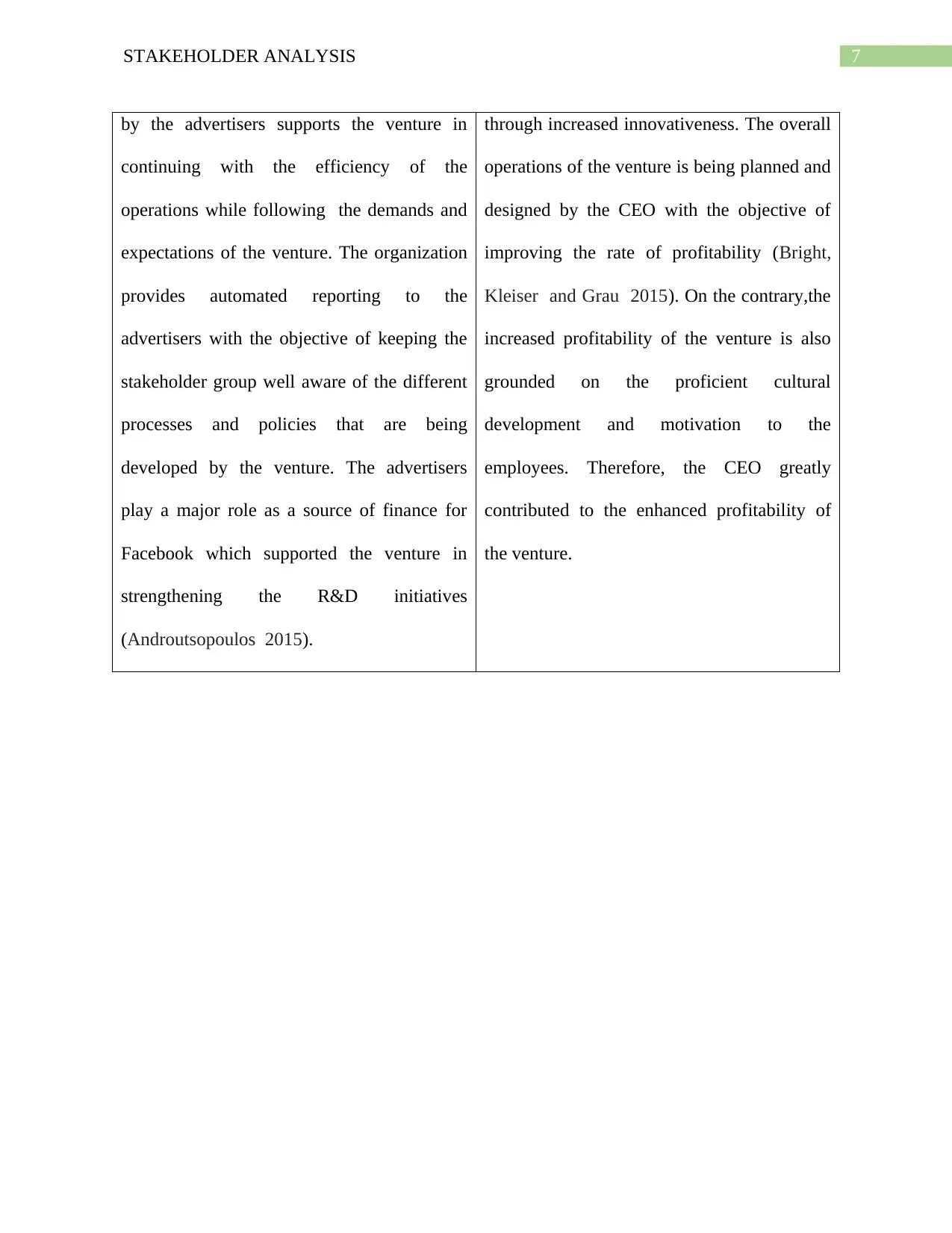
7STAKEHOLDER ANALYSIS
by the advertisers supports the venture in
continuing with the efficiency of the
operations while following the demands and
expectations of the venture. The organization
provides automated reporting to the
advertisers with the objective of keeping the
stakeholder group well aware of the different
processes and policies that are being
developed by the venture. The advertisers
play a major role as a source of finance for
Facebook which supported the venture in
strengthening the R&D initiatives
(Androutsopoulos 2015).
through increased innovativeness. The overall
operations of the venture is being planned and
designed by the CEO with the objective of
improving the rate of profitability (Bright,
Kleiser and Grau 2015). On the contrary,the
increased profitability of the venture is also
grounded on the proficient cultural
development and motivation to the
employees. Therefore, the CEO greatly
contributed to the enhanced profitability of
the venture.
by the advertisers supports the venture in
continuing with the efficiency of the
operations while following the demands and
expectations of the venture. The organization
provides automated reporting to the
advertisers with the objective of keeping the
stakeholder group well aware of the different
processes and policies that are being
developed by the venture. The advertisers
play a major role as a source of finance for
Facebook which supported the venture in
strengthening the R&D initiatives
(Androutsopoulos 2015).
through increased innovativeness. The overall
operations of the venture is being planned and
designed by the CEO with the objective of
improving the rate of profitability (Bright,
Kleiser and Grau 2015). On the contrary,the
increased profitability of the venture is also
grounded on the proficient cultural
development and motivation to the
employees. Therefore, the CEO greatly
contributed to the enhanced profitability of
the venture.
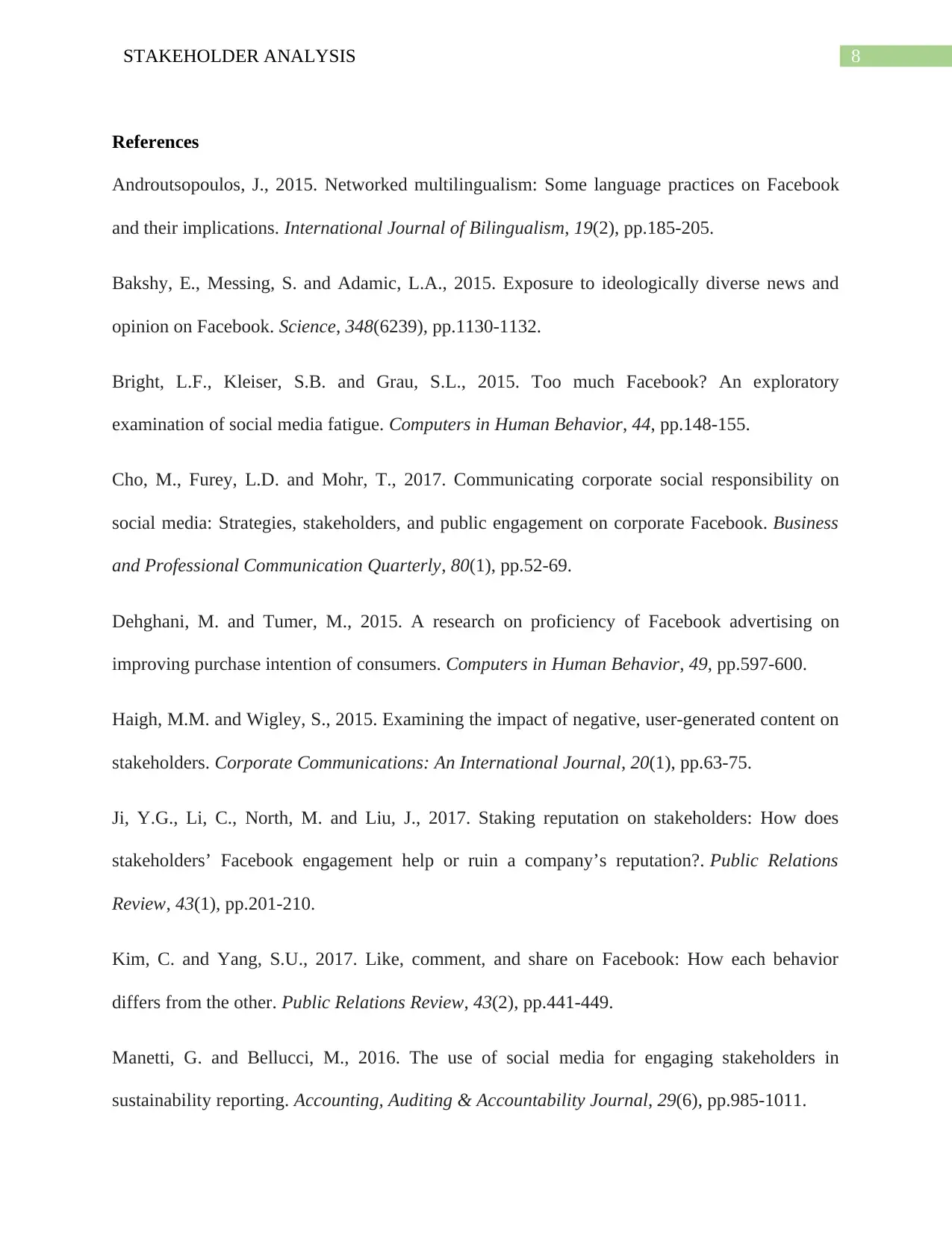
8STAKEHOLDER ANALYSIS
References
Androutsopoulos, J., 2015. Networked multilingualism: Some language practices on Facebook
and their implications. International Journal of Bilingualism, 19(2), pp.185-205.
Bakshy, E., Messing, S. and Adamic, L.A., 2015. Exposure to ideologically diverse news and
opinion on Facebook. Science, 348(6239), pp.1130-1132.
Bright, L.F., Kleiser, S.B. and Grau, S.L., 2015. Too much Facebook? An exploratory
examination of social media fatigue. Computers in Human Behavior, 44, pp.148-155.
Cho, M., Furey, L.D. and Mohr, T., 2017. Communicating corporate social responsibility on
social media: Strategies, stakeholders, and public engagement on corporate Facebook. Business
and Professional Communication Quarterly, 80(1), pp.52-69.
Dehghani, M. and Tumer, M., 2015. A research on proficiency of Facebook advertising on
improving purchase intention of consumers. Computers in Human Behavior, 49, pp.597-600.
Haigh, M.M. and Wigley, S., 2015. Examining the impact of negative, user-generated content on
stakeholders. Corporate Communications: An International Journal, 20(1), pp.63-75.
Ji, Y.G., Li, C., North, M. and Liu, J., 2017. Staking reputation on stakeholders: How does
stakeholders’ Facebook engagement help or ruin a company’s reputation?. Public Relations
Review, 43(1), pp.201-210.
Kim, C. and Yang, S.U., 2017. Like, comment, and share on Facebook: How each behavior
differs from the other. Public Relations Review, 43(2), pp.441-449.
Manetti, G. and Bellucci, M., 2016. The use of social media for engaging stakeholders in
sustainability reporting. Accounting, Auditing & Accountability Journal, 29(6), pp.985-1011.
References
Androutsopoulos, J., 2015. Networked multilingualism: Some language practices on Facebook
and their implications. International Journal of Bilingualism, 19(2), pp.185-205.
Bakshy, E., Messing, S. and Adamic, L.A., 2015. Exposure to ideologically diverse news and
opinion on Facebook. Science, 348(6239), pp.1130-1132.
Bright, L.F., Kleiser, S.B. and Grau, S.L., 2015. Too much Facebook? An exploratory
examination of social media fatigue. Computers in Human Behavior, 44, pp.148-155.
Cho, M., Furey, L.D. and Mohr, T., 2017. Communicating corporate social responsibility on
social media: Strategies, stakeholders, and public engagement on corporate Facebook. Business
and Professional Communication Quarterly, 80(1), pp.52-69.
Dehghani, M. and Tumer, M., 2015. A research on proficiency of Facebook advertising on
improving purchase intention of consumers. Computers in Human Behavior, 49, pp.597-600.
Haigh, M.M. and Wigley, S., 2015. Examining the impact of negative, user-generated content on
stakeholders. Corporate Communications: An International Journal, 20(1), pp.63-75.
Ji, Y.G., Li, C., North, M. and Liu, J., 2017. Staking reputation on stakeholders: How does
stakeholders’ Facebook engagement help or ruin a company’s reputation?. Public Relations
Review, 43(1), pp.201-210.
Kim, C. and Yang, S.U., 2017. Like, comment, and share on Facebook: How each behavior
differs from the other. Public Relations Review, 43(2), pp.441-449.
Manetti, G. and Bellucci, M., 2016. The use of social media for engaging stakeholders in
sustainability reporting. Accounting, Auditing & Accountability Journal, 29(6), pp.985-1011.
⊘ This is a preview!⊘
Do you want full access?
Subscribe today to unlock all pages.

Trusted by 1+ million students worldwide
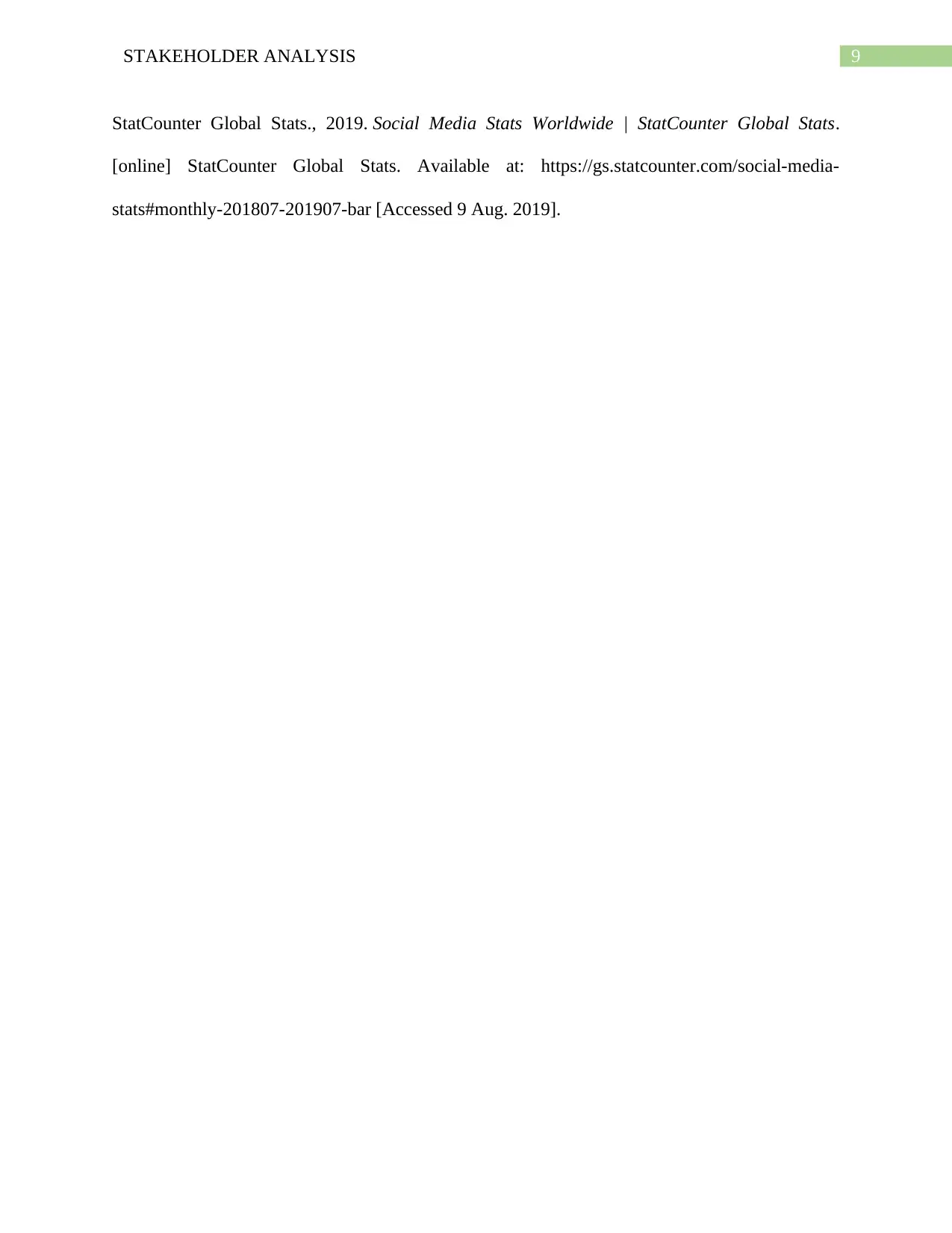
9STAKEHOLDER ANALYSIS
StatCounter Global Stats., 2019. Social Media Stats Worldwide | StatCounter Global Stats.
[online] StatCounter Global Stats. Available at: https://gs.statcounter.com/social-media-
stats#monthly-201807-201907-bar [Accessed 9 Aug. 2019].
StatCounter Global Stats., 2019. Social Media Stats Worldwide | StatCounter Global Stats.
[online] StatCounter Global Stats. Available at: https://gs.statcounter.com/social-media-
stats#monthly-201807-201907-bar [Accessed 9 Aug. 2019].
1 out of 10
Related Documents
Your All-in-One AI-Powered Toolkit for Academic Success.
+13062052269
info@desklib.com
Available 24*7 on WhatsApp / Email
![[object Object]](/_next/static/media/star-bottom.7253800d.svg)
Unlock your academic potential
Copyright © 2020–2025 A2Z Services. All Rights Reserved. Developed and managed by ZUCOL.





